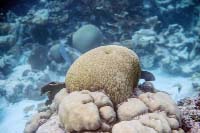
AFP, Noumea :
New Caledonia agreed Tuesday to tougher protections around a huge swathe of some of the world’s last near-pristine coral reefs, in a move conservationists hailed as a major breakthrough.
The Pacific nation, a French overseas territory, is home to a rich array of wildlife including 2.5 million seabirds and over 9,300 marine species, such as dugongs – marine mammals related to manatees – and nesting green sea turtles, many of which thrive in and around remote zones off the island nation’s coast.
The archipelago boasts some of the world’s healthiest reefs, including Astrolabe, Petrie, Chesterfield and Bellona, which are considered exceptional examples of coral ecosystems.
After years of work, the New Caledonia government Tuesday voted to set up marine protected areas (MPAs) surrounding the reefs, and to strengthen an existing one around Entrecasteaux, which is already a UNESCO World Heritage site.
The move will see 28,000 square kilometres (10,810 square miles) of waters safeguarded from commercial and industrial fishing and other exploitation, helping conserve habitats and allow marine life to feed and reproduce undisturbed.
Tourist activity around the reefs is also set to be more rigorously controlled.
New Caledonia agreed Tuesday to tougher protections around a huge swathe of some of the world’s last near-pristine coral reefs, in a move conservationists hailed as a major breakthrough.
The Pacific nation, a French overseas territory, is home to a rich array of wildlife including 2.5 million seabirds and over 9,300 marine species, such as dugongs – marine mammals related to manatees – and nesting green sea turtles, many of which thrive in and around remote zones off the island nation’s coast.
The archipelago boasts some of the world’s healthiest reefs, including Astrolabe, Petrie, Chesterfield and Bellona, which are considered exceptional examples of coral ecosystems.
After years of work, the New Caledonia government Tuesday voted to set up marine protected areas (MPAs) surrounding the reefs, and to strengthen an existing one around Entrecasteaux, which is already a UNESCO World Heritage site.
The move will see 28,000 square kilometres (10,810 square miles) of waters safeguarded from commercial and industrial fishing and other exploitation, helping conserve habitats and allow marine life to feed and reproduce undisturbed.
Tourist activity around the reefs is also set to be more rigorously controlled.

